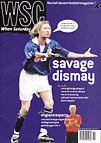 Continuing our occasional series on defunct competitions, Lionel Birnie dons his plimsolls and recalls the glory days of the televised indoor tournaments
Continuing our occasional series on defunct competitions, Lionel Birnie dons his plimsolls and recalls the glory days of the televised indoor tournaments
Despite increasingly sophisticated coaching methods, the humble five-a-side has endured. It is still the traditional way for teams to round off the last training session of the week. But despite its far-reaching popularity, no one would think of organising an indoor tournament for Premiership clubs. Can you imagine Sir Alex’s face if he was asked by the FA to send David, Roy and Juan Sebastian to the G-Mex the night before a Champions League match?
It just wouldn’t happen. These days five-a-side tournaments are the preserve of barrel-chested old pros, but back in the Eighties, when English football was frozen out of Europe, indoor football enjoyed a heyday it is unlikely to see again. The Evening Standard Fives, Daily Express national Five-a-Side and Soccer Six tournaments were an exciting diversion from the rigours of the old First Division.
London clubs had enjoyed an annual night out at Wembley Arena for the Evening Standard event since the Fifties. Millwall particularly enjoyed themselves, winning the title three times in six years in the late Seventies and early Eighties. This run included a thrilling final in 1984 when I saw a team featuring a 17-year-old Teddy Sheringham hold on to a 3-2 lead against a Brentford side including master clogger Chris Kamara for a full three minutes – a long time in five-a-side.
But it was the Daily Express competition that sparked television’s interest. Scottish clubs were invited to enter and, although the roll of winners is hardly illustrious, these carefree evenings provided ITV with an hour or so of highlights complete with the echo of a thousand schoolboy voices.
The Football League decided to get in on the act. Inspired by the example of America’s Major Indoor Soccer League (whose initials were sometimes cruelly said to stand for the Midgets in Sneakers League), the Soccer Six was born. A pilot tournament for midlands teams, sponsored by the games console manufacturer Atari, was held at the National Exhibition Centre in 1981. Birmingham City beat Wolves in the final, with Kevin Dillon winning the player of the tournament award. The competition was judged a success and the Football League was ready to take it to the nation, inviting the rest of the First Division to enter.
Soccer Six was frantic stuff. Unlike the five-a-side tournaments which had touchlines and kick-ins, the ball was kept permanently in play by a Plexiglass wall, which could be used as an extra man by playing one-twos off it. The goals were bigger and there was no height restriction, so players were encouraged to attempt spectacular, long-range shots. Stuart Pearce might shoot from his own half only to see the ball bounce off the wall back to his keeper. Five minutes each way, a sin-bin and rolling substitutions only added to the allure.
The beauty of five- or six-a-side has always been its ad hoc attitude to rules. Many a game in the playground or sports centre has started with a lengthy debate as to what restrictions should be used, before settling on: “Nothing over head height, rush goalie and no shooting from behind the blue line.” The organised tournaments’ crucial failing was that they were too regimented. We didn’t want group stages, goal difference and penalty shoot-outs, we wanted to see 8-8 stalemates settled only when Peter Davenport or Neil Webb stopped the game to shout: “Next goal wins.”
Five-a-side is a great leveller. Everyone has played it and can identify with its capacity to stretch lungs to the limits within a few minutes. But it was incongruous to see First Division footballers wearing trainers, particularly those who opted for white Dunlop Green Flash-style sneakers. It just didn’t look right to see them squeaking around on the carpet chasing a giant tennis ball. It was also unsettling to hear, just audible above the pre-adolescent din, that professional players shouted the same inane nonsense we did: “Man on”, “square ball” or “give and go”.
But this was football for the masses, often seeming to reduce professional footballers to the level of amateurs. The players, too, demonstrated that they understood the spirit of five-a-side. After Watford lost to Manchester United on penalties in the 1986 Soccer Six, their manager Dave Bassett confirmed that professional players do the same as anyone else when they come off the court, red-faced and drenched in sweat: “There were a few drinks in the hospitality suite and we got in some Kentucky Fried Chicken.”
That was the year the competition was moved to the G-Mex centre in Manchester, complete with a lucrative sponsorship deal with Guinness. With qualifying matches on Monday and Tuesday evening and finals night on Wednesday, the format was already threatening to mushroom out of control. It was a hit with the BBC’s Sportsnight programme, though, and Oxford United toppled Arsenal in the final. Nottingham Forest and Charlton Athletic toasted their respective victories with a touch of the black stuff but by the time English clubs were readmitted to Europe in 1990 the writing was on the wall and top flight six-a-side became a casualty of fixture congestion. The big clubs were unwilling to risk their star players, while television and sponsors weren’t to be attracted by matches involving reserve players.
Now the same generation of players who graced the carpets in the Eighties are turning out in retro shirts in the Carling Masters tournaments, while small-sided football also prospers on the beaches of Copacabana and Monte Carlo. However, if anyone wants to revive the tournament, there is hope. Apparently that the old green pitch is still rolled up and stored away somewhere at Football League headquarters.
From WSC 177 November 2001. What was happening this month